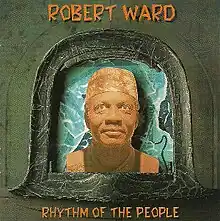| Rhythm of the People | ||||
|---|---|---|---|---|
 | ||||
| Studio album by | ||||
| Released | 1993 | |||
| Studio | Arlyn | |||
| Genre | R&B, blues | |||
| Label | Black Top[1] | |||
| Producer | Hammond Scott | |||
| Robert Ward chronology | ||||
| ||||
Rhythm of the People is an album by the American musician Robert Ward, released in 1993.[2][3]
Production
Produced by Hammond Scott, the majority of the album was recorded at Arlyn Studios, in Austin, Texas.[4][5] "I Found a Love" was recorded in New Orleans, with bass player George Porter Jr.[5] The Kamikaze Horns played on some of the songs.[6] Ward's wife Roberta sang on some of the gospel-influenced tracks.[7]
Ward used his Magnatone amp on the album.[8] The musician felt that Rhythm of the People was a better representation of his musical interests than his previous album, Fear No Evil.[9]
Critical reception
The Edmonton Journal noted that "Ward's taste for fast, gutsy, clear, making-every-note-count attacks on the fingerboard was an influence on Stevie Ray Vaughan and others."[6] The Chicago Tribune stated that "a couple of alleged originals borrow too heavily from vintage R & B sources."[8] The Denver Post opined that "the element of surprise is gone—and some of Ward's new songs are a little preachy ... But there still are enough beautiful classic-soul moments."[16]
The Gazette determined that "a tastier mix of contemporary soul, gospel and R&B is hard to imagine."[17] The Los Angeles Times concluded that "Ward seems so re-energized that he occasionally pushes his voice too hard, but the music is punchier and its gospel-rooted flavor and message are even more in evidence."[13] The Toronto Sun deemed the album "essential for anyone who's ever thrilled to the sounds of Stax-Volt, Motown, or '60s soul and R & B in general."[15]
AllMusic wrote that Ward's "vocals don't sound nearly as hearty this time around, and a some of the songs just aren't up to par."[10]
Track listing
| No. | Title | Length |
|---|---|---|
| 1. | "A Good Man" | |
| 2. | "The Real Deal" | |
| 3. | "Say What You Mean" | |
| 4. | "White Fox" | |
| 5. | "You Can't Stop My Lovin' Now" | |
| 6. | "Children of the World (Don't Forget to Pray)" | |
| 7. | "All Proud Races" | |
| 8. | "I Do What I Want" | |
| 9. | "What a Friend We Have In Jesus" | |
| 10. | "Some Things" | |
| 11. | "Soap Opera Blues" | |
| 12. | "I Found a Love" | |
| 13. | "Twiggs County" |
References
- ↑ Komara, Edward (2006). Encyclopedia of the Blues. Routledge. p. 1049.
- ↑ "Robert Ward Biography, Songs, & Albums". AllMusic. Archived from the original on 2018-06-21. Retrieved 2022-10-17.
- ↑ "Obituary: Robert Ward". the Guardian. March 4, 2009. Archived from the original on October 17, 2022. Retrieved October 17, 2022.
- ↑ "Rhythm of the People by Robert Ward". Billboard. 105 (18): 50. May 1, 1993.
- 1 2 Point, Michael (15 Apr 1993). "Taste a sample of the blues". Austin American-Statesman. p. C13.
- 1 2 Levesque, Roger (10 May 1993). "Blues". Edmonton Journal. p. B7.
- 1 2 Larkin, Colin (2006). The Encyclopedia of Popular Music. Vol. 8. MUZE. p. 508.
- 1 2 3 Dahl, Bill (13 May 1993). "Robert Ward Rhythm of the People". Tempo. Chicago Tribune. p. 7.
- ↑ Dahl, Bill (17 Sep 1993). "FEAR NOT: GUITARIST ROBERT WARD IS ON THE WAY BACK". Friday. Chicago Tribune. p. S.
- 1 2 "Robert Ward - Rhythm of the People Album Reviews, Songs & More | AllMusic". Archived from the original on 2022-10-17. Retrieved 2022-10-17 – via www.allmusic.com.
- ↑ "Robert Christgau: CG: Robert Ward". www.robertchristgau.com. Archived from the original on 2022-10-17. Retrieved 2022-10-17.
- ↑ Hadley, Frank-John (Jul 1993). "Blues hoodoo". DownBeat. 60 (7): 42.
- 1 2 Snowden, Don (9 Jan 1994). "Finding America's Lost R&B Masters". Calendar. Los Angeles Times. p. 60.
- ↑ MusicHound Blues: The Essential Album Guide. Visible Ink Press. 1998. p. 383.
- 1 2 Sakamoto, John (May 16, 1993). "Robert Ward Rhythm of the People". Toronto Sun. p. S7.
- ↑ Rosen, Steven (June 11, 1993). "Robert Ward's 'Fear No Evil' album was the blues/R&B treasure of 1991...". The Denver Post. p. 26.
- ↑ Lamey, Mary (3 Sep 1993). "Spectrum ranges from Glaswegian blues to Iroquoian pop". The Gazette. Montreal. p. C4.